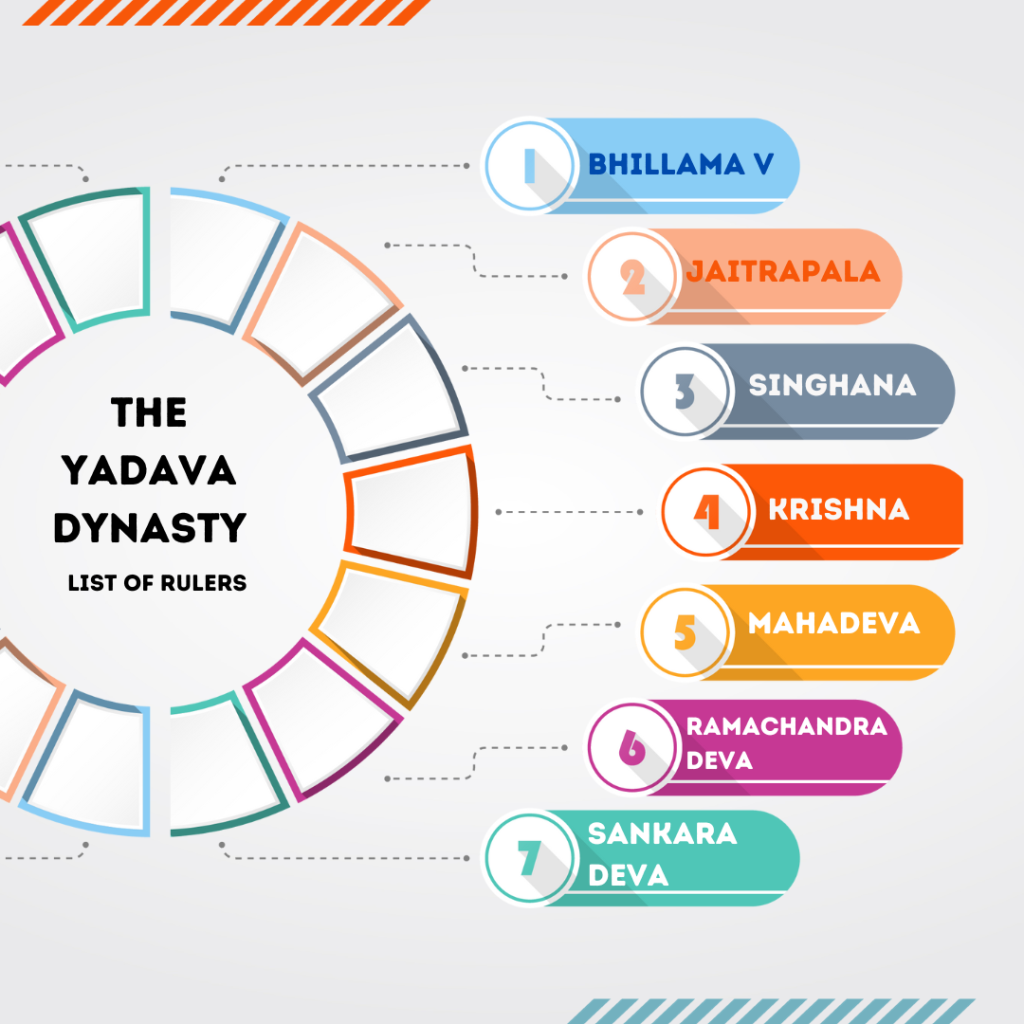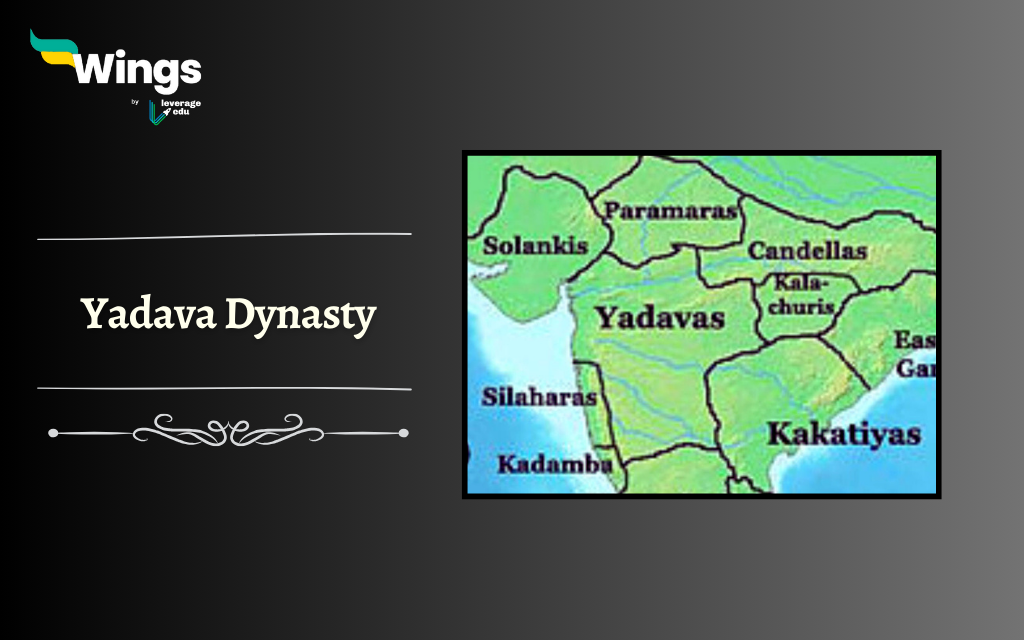The Yadava Dynasty, also known as the Seuna Dynasty, was a medieval Indian dynasty that ruled over large parts of present-day Maharashtra, Karnataka, and Telangana from the 12th to the 14th centuries. According to some sources, the Yadava Dynasty traces its origins back to the ancient Yadu clan, which in turn belongs to the lineage of Lord Krishna. This illustrious dynasty left a lasting impact on the political, cultural, and economic scenario of the Deccan region. In this article, we will delve into the history, list of kings, economy, and the decline of the Yadava Dynasty.
Contents

History of the Yadava Dynasty
The Yadava Dynasty was a prominent medieval Indian power that ruled over the Deccan region. Their history is marked by cultural growth, military strength, and regional influence. Here are the key points on the history of the Yadava Dynasty.
- Origins: The dynasty is believed to have originated from the Yadava clan mentioned in ancient texts like the Mahabharata.
- Seuna or Sevuna Dynasty: The rulers are often referred to as the Seuna or Sevuna Yadavas and were originally feudatories of the Western Chalukyas.
- Capital at Devagiri: The Yadavas made Devagiri (modern-day Daulatabad in Maharashtra) their capital, which became a centre of power and culture.
- Founder: Dridhaprahara is considered the founder of the dynasty, establishing its roots in the 9th century CE.
- Expansion Under Bhillama V: The dynasty rose to prominence under Bhillama V, who declared independence from the Chalukyas in the 12th century.
- Reign of Singhana II: The empire reached its zenith during the reign of Singhana II (c. 1210–1247 CE), expanding territory and promoting literature and architecture.
- Cultural Patronage: The Yadavas supported Marathi and Sanskrit literature, with scholars like Hemadri flourishing during their reign.
- Conflict with the Delhi Sultanate: In the early 14th century, the Yadavas were defeated by Alauddin Khilji, leading to the dynasty’s decline.
- End of Rule: The dynasty ended when Malik Kafur, a general of the Delhi Sultanate, captured Devagiri in 1317 CE.
- Legacy: Despite their fall, the Yadavas left a lasting mark on regional culture, especially in Maharashtra.
Also Read – List of Maratha Rulers, History, Rise and Journey
Who were the Rulers of the Yadava Dynasty?
The Yadava Dynasty ruled parts of western and central India during the medieval period. Known for their valour and patronage of art, they played a key role in regional history. Here is a list of the kings of the Yadava Dynasty –
| Rulers | Year | Detail |
| Bhillama V | 1175-1190 A.D | Bhillama V was the founder of the independent Yadava Dynasty and ruled as the first king. He successfully expanded his kingdom but lost his life in the battle of Lakkundi. |
| Jaitrapala | 1191-1210 A.D | Also known as Jaitugi, the second king of the Yadavas continued the legacy of Bhillama V and further strengthened the empire by defeating Kakatiyas, Guraras and Kalachuris. He was known for his diplomatic skills and ability to maintain harmonious relations with neighbouring kingdoms. |
| Singhana | 1210- 1247 A.D | Under the reign of Simhana, the Dynasty reached its pinnacle of power. He defeated rulers like Mahadeva of Kakatiya and Vira-Ballala of Hoysala. He even expanded the territory by annexing the Kolhapur region. He became dominant over the Hoysalas, Kakatiyas, Paramaras and the Chalukyas. |
| Krishna | 1247-1260 A.D | Krishna was the grandson of Singhana and was a visionary ruler. During his rule, the famous Vedantakalpataru was written. |
| Mahadeva | 1260-1271 A.D | He captured the Silhara Dynasty and was the brother of Krishna. He was considered an empathetic ruler. |
| Ramachandra Deva | 1271 – 1309 A.D | Ramachandra was one of the last significant rulers of the Dynasty and faced numerous challenges during his reign. Finally, Ala-ud-din Khilji defeated him and took the kingdom under his reign. |
| Sankara Deva | 1309-1323 A.D | He was the Successor of Ramachandra. Although he was killed by Malik Kafur in 1312 A.D. However, his brother-in-law continued the fight on his behalf but was defeated by Ala-ud-din Khilji’s son Mubarak. |
How was the Administration of the Yadava Dynasty?
The Deccan kingdoms followed almost similar administrative processes during their reign. The administrations under the Yadavas were also similar. These are the key features of the Yadava Dynasty Administration.
- Monarchical Rule: The king was the supreme authority and played a central role in administration, justice, and military decisions.
- Council of Ministers: A group of advisors assisted the king in governance, including ministers for finance, war, foreign affairs, and religious matters.
- Provincial Administration: The empire was divided into provinces (mandalas), each headed by governors or local chieftains responsible for law and order.
- Revenue System: Land revenue was the main source of income. Taxes were collected systematically based on land fertility and crop yield.
- Military Organization: The Yadavas maintained a strong army, including cavalry, infantry, and war elephants, to protect their territories and expand their kingdom.
- Judicial System: Justice was administered by the king and his officials, often based on Dharmaśāstra (ancient legal texts).
- Public Works and Welfare: They built temples, tanks, and irrigation systems, showing concern for social welfare and infrastructure development.
- Religious Tolerance: Though they were patrons of Hinduism, the Yadavas showed respect toward other religions and sects.
Also Read – Development of Railways in India
Economy during the Yadava Rule
The Dynasty had a flourishing economy and played a great role in promoting trade and commerce by establishing trade routes and supporting local artisans and merchants.
- There were many taxes imposed for various purposes for –
| Imposition of Tax on | Tax Name |
| Farmland | Aruvana Tax |
| Market Tax Income | Santhey-Aya |
| Professional taxes for Carpenters, Blacksmiths, Cobblers, Washermen, etc | Bannige |
| Personal Tax for exceptional situations | Talevana |
- Sunkadhikari were the primary tax collectors and had the responsibility of managing the treasury of the state.
- The official in charge of the royal treasury was the Mahabhandari.
- People who were engaged in Trade and Business were called Settis and Vyavaharas. oil dealers were called Teligas, and dealers in betel leaves were called Gatrigas or Hannavanigas.
- The most powerful trading organisation in South India were the Virabalanja, which had its headquarters in Aihole and had multiple branches in several cities.
Here are the Key Highlights of the Yadava Economy:
- Agriculture was the backbone: Fertile land and river systems supported crops like rice, wheat, pulses, and sugarcane.
- Irrigation development: The rulers built tanks, canals, and wells to improve the water supply for farming.
- Land revenue system: A structured system that collected taxes from farmers, which was a major income source for the state.
- Thriving internal trade: Local markets exchanged goods like textiles, spices, and metals within the kingdom.
- Foreign trade connections: Ports on the West Coast enabled trade with the Arab world and Southeast Asia.
- Support for artisans and craftsmen: Weavers, potters, and metalworkers enjoyed royal patronage and contributed to the economy.
- Urban economic centres: Cities like Devagiri became hubs of administration, trade, and culture.
- Use of currency: Coins made of gold, silver, and copper were in circulation, facilitating smooth trade.
- Temple economy: Temples were not just religious centres but also economic hubs with land holdings and donations.
- Stable governance encouraged growth: Peaceful rule and efficient administration allowed commerce and agriculture to flourish.
Decline of the Yadava Dynasty
The Yadava Dynasty, once a powerful force in the Deccan region, saw a gradual decline due to internal weaknesses and external invasions. Here’s a quick look at what led to their fall:
- Cultural Disruption: The shift in power also disrupted local administration and patronage of arts and literature.
- Weak Successors: After the death of strong rulers like Singhana II, the later kings lacked leadership skills and administrative strength.
- Internal Conflicts: Power struggles within the royal family weakened the central authority and created instability.
- Neglect of Military: Over time, the dynasty became complacent and failed to maintain a strong and modern military force.
- Rise of the Delhi Sultanate: The growing power of the Delhi Sultanate under Alauddin Khilji posed a serious threat to the Yadavas.
- Invasion by Alauddin Khilji (1296 CE): Alauddin Khilji invaded Devagiri (the Yadava capital), defeated King Ramachandra, and forced him to become a vassal.
- Annexation by Malik Kafur (1317 CE): Malik Kafur, a general of the Delhi Sultanate, fully annexed the Yadava kingdom, marking the dynasty’s end.
- Economic Strain: Constant warfare and tribute payments to the Sultanate drained the kingdom’s wealth and resources.
Furthermore, the Yadavas faced resistance from other emerging kingdoms in the region, which sought territorial expansion. This, coupled with internal divisions within the dynasty, ultimately led to its downfall. In the early 14th century, the Yadava Dynasty was finally overthrown by the Delhi Sultanate, marking the end of their imperial rule.
Relevant Blogs
| Maratha Empire (1674-1818) | Indian Press Act of 1910 |
| Salt Satyagraha Movement | Ahmedabad Mill Strike of 1918 |
| Sayyid Dynasty | Cabinet Mission of 1946 |
FAQs
The founder of the Yadava dynasty was Dridhaprahara. His lineage established the early roots of the kingdom that would later expand significantly under his successors in the Deccan region of India.
The Yadava dynasty was ultimately destroyed by the Delhi Sultanate. Specifically, Sultan Alauddin Khalji’s forces launched repeated invasions and plundered Devagiri, weakening and eventually annexing the Yadava kingdom into the Sultanate’s vast empire.
The Yadavas were primarily devotees of Krishna, an avatar of Vishnu. They considered themselves descendants of Yadu, an ancient king from whom Krishna also hailed. Their religious practices were deeply intertwined with Vaishnavism.
The Yadava dynasty primarily flourished from the 9th century CE, with their significant power emerging around the late 12th century, until their decline and eventual fall to the Delhi Sultanate in the early 14th century CE.
The capital of the Yadava dynasty was Devagiri, which means “Hill of Gods.” This strategically important city, later renamed Daulatabad, served as their main administrative and military centre.
The Yadava Dynasty was a prominent force during the medieval period in India. Its rise to power, economic contributions, and eventual decline showcase the ebb and flow of dynastic power during the medieval period. That’s all about the Yadava Dynasty! If you want to know more about topics like this, then visit our general knowledge page! Alternatively, you can also read our blog on general knowledge for competitive exams!
 One app for all your study abroad needs
One app for all your study abroad needs














